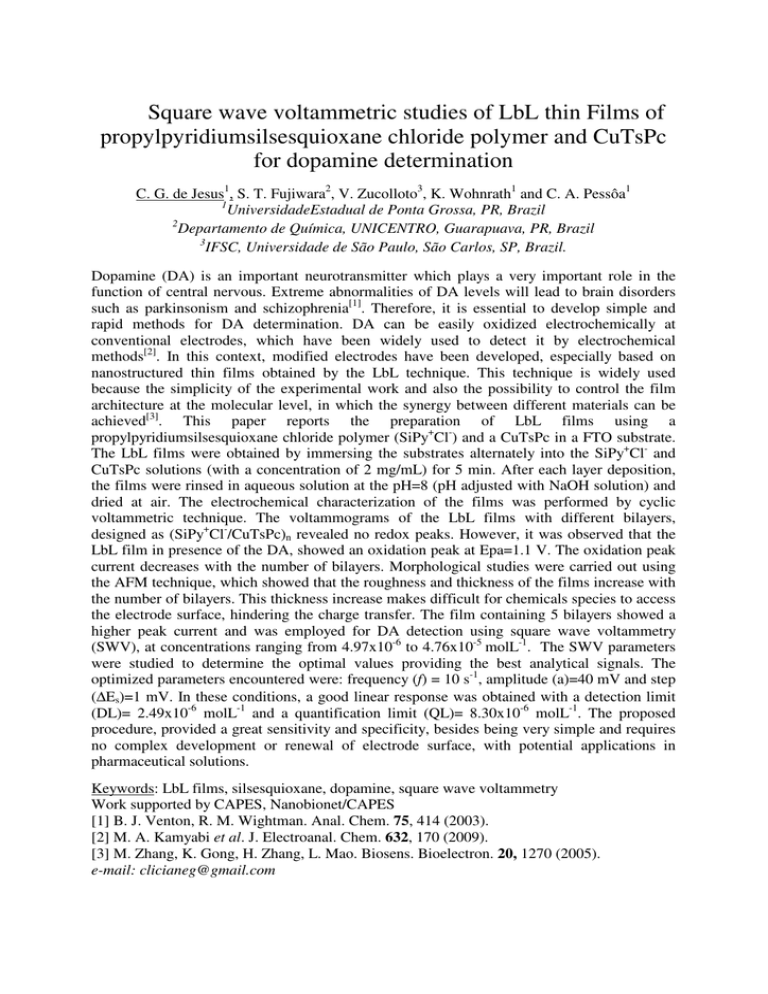Square wave voltammetric studies of LbL thin Films of
advertisement

Square wave voltammetric studies of LbL thin Films of propylpyridiumsilsesquioxane chloride polymer and CuTsPc for dopamine determination C. G. de Jesus1, S. T. Fujiwara2, V. Zucolloto3, K. Wohnrath1 and C. A. Pessôa1 1 UniversidadeEstadual de Ponta Grossa, PR, Brazil 2 Departamento de Química, UNICENTRO, Guarapuava, PR, Brazil 3 IFSC, Universidade de São Paulo, São Carlos, SP, Brazil. Dopamine (DA) is an important neurotransmitter which plays a very important role in the function of central nervous. Extreme abnormalities of DA levels will lead to brain disorders such as parkinsonism and schizophrenia[1]. Therefore, it is essential to develop simple and rapid methods for DA determination. DA can be easily oxidized electrochemically at conventional electrodes, which have been widely used to detect it by electrochemical methods[2]. In this context, modified electrodes have been developed, especially based on nanostructured thin films obtained by the LbL technique. This technique is widely used because the simplicity of the experimental work and also the possibility to control the film architecture at the molecular level, in which the synergy between different materials can be achieved[3]. This paper reports the preparation of LbL films using a propylpyridiumsilsesquioxane chloride polymer (SiPy+Cl-) and a CuTsPc in a FTO substrate. The LbL films were obtained by immersing the substrates alternately into the SiPy+Cl- and CuTsPc solutions (with a concentration of 2 mg/mL) for 5 min. After each layer deposition, the films were rinsed in aqueous solution at the pH=8 (pH adjusted with NaOH solution) and dried at air. The electrochemical characterization of the films was performed by cyclic voltammetric technique. The voltammograms of the LbL films with different bilayers, designed as (SiPy+Cl-/CuTsPc)n revealed no redox peaks. However, it was observed that the LbL film in presence of the DA, showed an oxidation peak at Epa=1.1 V. The oxidation peak current decreases with the number of bilayers. Morphological studies were carried out using the AFM technique, which showed that the roughness and thickness of the films increase with the number of bilayers. This thickness increase makes difficult for chemicals species to access the electrode surface, hindering the charge transfer. The film containing 5 bilayers showed a higher peak current and was employed for DA detection using square wave voltammetry (SWV), at concentrations ranging from 4.97x10-6 to 4.76x10-5 molL-1. The SWV parameters were studied to determine the optimal values providing the best analytical signals. The optimized parameters encountered were: frequency (f) = 10 s-1, amplitude (a)=40 mV and step (∆Es)=1 mV. In these conditions, a good linear response was obtained with a detection limit (DL)= 2.49x10-6 molL-1 and a quantification limit (QL)= 8.30x10-6 molL-1. The proposed procedure, provided a great sensitivity and specificity, besides being very simple and requires no complex development or renewal of electrode surface, with potential applications in pharmaceutical solutions. Keywords: LbL films, silsesquioxane, dopamine, square wave voltammetry Work supported by CAPES, Nanobionet/CAPES [1] B. J. Venton, R. M. Wightman. Anal. Chem. 75, 414 (2003). [2] M. A. Kamyabi et al. J. Electroanal. Chem. 632, 170 (2009). [3] M. Zhang, K. Gong, H. Zhang, L. Mao. Biosens. Bioelectron. 20, 1270 (2005). e-mail: clicianeg@gmail.com





